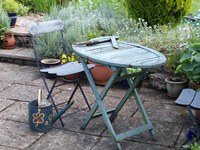Dakota Gardener: Get ready to grow with spring garden prep
(Click an image below to view a high-resolution image that can be downloaded)
By Emily How, Horticulture agent
NDSU Extension – Ward County
It’s that time of year when I start pulling out all my garden tools and begin looking at the garden. I do not do a lot of prep with my garden; I prefer to enjoy the process and not focus on every weed or imperfect flower that is definitely there. That said, there are a few garden preparations I always do to help keep my garden in decent shape.
The first thing I do is locate my tools. Somehow, every year I seem to forget that winter is coming, and my tools don’t always end up where they should be. For example, my favorite pruners were in the shed just sitting on our patio furniture. Apparently, I set them down and forgot to go back for them.
Because the tools don’t always make it back to where they belong, I always make sure they are in decent shape. This may mean greasing the joints or taking the pruners to get sharpened. It is important to have sharp, well-working tools in the garden. Dull blades can lead to tearing of plant tissue, which makes it more difficult for the plant to recover and more susceptible to disease or other pests.
Organizing my shed for the summer is also important; this way, everything I need while gardening is easily found and accessible.
When it comes to the garden, I make sure to rotate where plants will grow. It is recommended that plants within the same family are not planted in the same area for more than three years. This practice helps reduce plant diseases in the garden and can help prevent soil nutrient depletion. Rotating crops lets the soil rest and recover certain nutrients. Some families, such as the mustard family (Brassicaceae), contain several common garden crops like broccoli, cabbage, Brussels sprouts and turnips. To make crop rotation easier, plant a variety of different crops.
Before the garden season begins, I try to “turn” my compost. Through the winter, my compost pile sits unturned, all the while I continue adding vegetable scraps. By the time the snow melts, the compost needs to be turned.
To turn my compost pile, I bring the material that is at the bottom to the top, the top to the middle, and the middle to the bottom. Turning is an important step in the breakdown of food scraps. It allows air to be added to the pile, which is important for the decomposers, and it prevents the compost pile from smelling. Turning also allows for moisture to be distributed through the pile and shows me if more moisture needs to be added.
The general rule of thumb for moisture levels in the compost pile is that you should be able to grab a handful of compost material, and when squeezed, it stays together but does not drip water. Turning my compost also gives me an idea of how much organic material I will have available to use for the year.
The very last thing that I do is grab my favorite chair from the shed and set it outside where I can drink my southern sweet tea and watch my garden grow. What is your garden prep process?
NDSU Agriculture Communication – May 14, 2025
Source: Emily How, 701-857-6444, emily.how@ndsu.edu
Editor: Kelli Anderson, 701-231-6136, kelli.c.anderson@ndsu.edu




